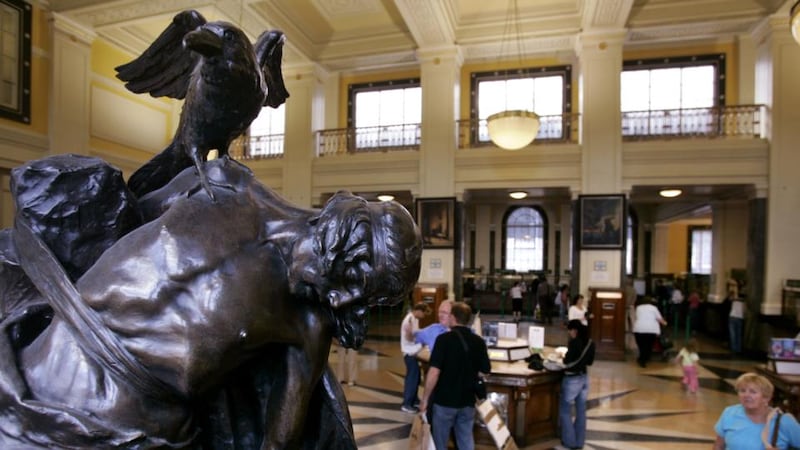What to do with the General Post Office (GPO) site on O’Connell Street has, ever since the 1916 Rising, generated controversy, performative outrage, piety and genuine concern. Talk of its commercial development, as seen in recent weeks, inevitably leads to assertions about it being, in the words of politicians in Aontú, “sacred ground” and the “heartbeat of our republic.” Sinn Féin has launched a petition to “save the GPO,” insisting the Government, which is proposing mixed commercial and cultural use of the large complex, has “turned its face against the preservation of our revolutionary history”.
But if it is broadly accepted that the GPO is closely tied to Irish national identity, it should also be accepted that identity has never been fixed. In 1923 the Free State’s cabinet planned to hand over the GPO site to the Catholic archbishop of Dublin for the construction of a new cathedral, a proposal abandoned due to legal complications.
In her book Dublin 1916: The Siege of the GPO (2009), Clair Wills clears a path through the historic fog of competing narratives around the building and its meaning. Following its destruction in 1916 it was restored and formally reopened in 1929 when WT Cosgrave was head of government. As someone who fought during the Rising, Cosgrave held the key to the new building with some credibility, but his message at the reopening was not just about its glorious past: the GPO was now, he insisted, “symbolical of the new order – and the Irish nation is progressing on the path of prosperity”. It was also where the State’s new radio service, 2RN, was based.
For those on the opposite side of the Civil War divide from Cosgrave, the GPO was a reminder of betrayal of the republican ideal. With Fianna Fáil winning power in 1932, political ownership of the GPO began to shift. In initiating the formation of an Easter Week Memorial Committee, and a plan to have a 1916 memorial placed in the GPO – Oliver Sheppard’s sculpture The Death of Cúchulainn – Fianna Fáil was accused of political partisanship by excluding its political opponents from involvement, despite their shared 1916 heritage.
READ MORE

WT Cosgrave refused to attend the ceremony in 1935 to mark the unveiling of the sculpture because there was too much “bitterness, suspicion and envy”, and “it is not possible to hide these national humiliations today or to cover them with a veil lifted from the bronze statue of Cúchulainn”. Republicans opposed to Fianna Fáil’s acceptance of the legitimacy of the State were also critical, and the ceremony in 1935 was notable for the arrival at the GPO of a rival republican procession, en route to Glasnevin Cemetery.
The GPO was a focal point in 1941, during the Emergency, with a military parade to mark the Rising’s 25th anniversary and a message of the need to protect Irish sovereignty, but by 1966, when Seán Lemass was taoiseach, the message he communicated, as a 1916 GPO veteran, was that the national task now was to “consolidate the economic foundations” of the State. In more recent decades, the GPO site has been the backdrop to a variety of protests and social outreach, including a soup kitchen. It is thus far from an exclusive “sacred ground” in relation to the 1916 legacy; that description is more fitting for the graves of the executed 1916 leaders at Arbour Hill, which, it was accepted by successive governments, needed to remain a place austerely dignified.
But the GPO is more complicated than that. It pre-dates the Rising, having opened in 1818. It has always been a post office, and indeed, was open for business on Easter Monday 1916 when its customers got such a rude awakening. The preparation of the GPO museum for the centenary of the Rising in 2016, which I participated in, saw An Post insist that as well as being a “witness to history”, its historic centrality to communications be emphasised. The Government wanted themes of inclusivity to be stressed, while there was also a focus on those who inhabited its hinterland. Citizen witnesses, and indeed victims, were also what prompted Patrick Pearse to surrender in 1916, a reminder that the burning GPO did not exist in splendid isolation but at the heart of a living city, and with that came responsibilities to respect both the living and the dead associated with it.
And that remains the case. Narrowing the debate to one about “sacred ground” is too restrictive. Given its iconic status, continued commercial function, and centrality to so many causes and communications, surely it is better that respect for its history is combined with a repurposing of the GPO area that would generate pride, and improve the perception of a space widely regarded as deficient and devoid of sufficient imagination for the main thoroughfare of a capital city.










